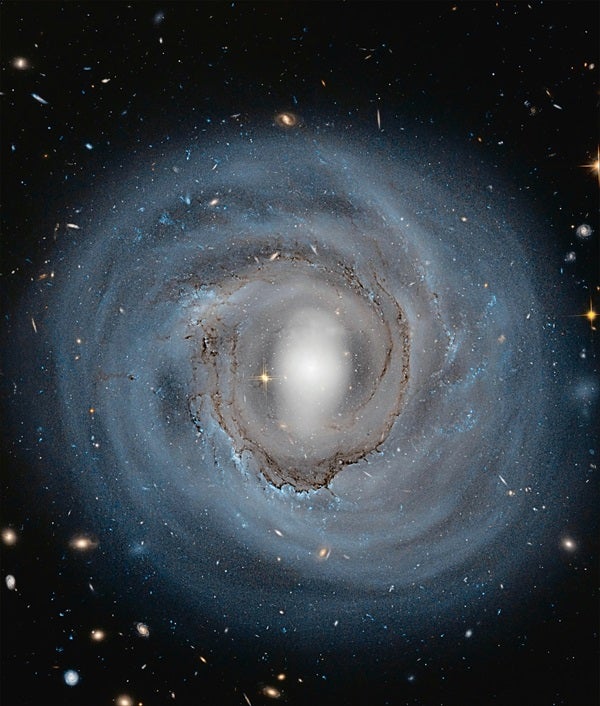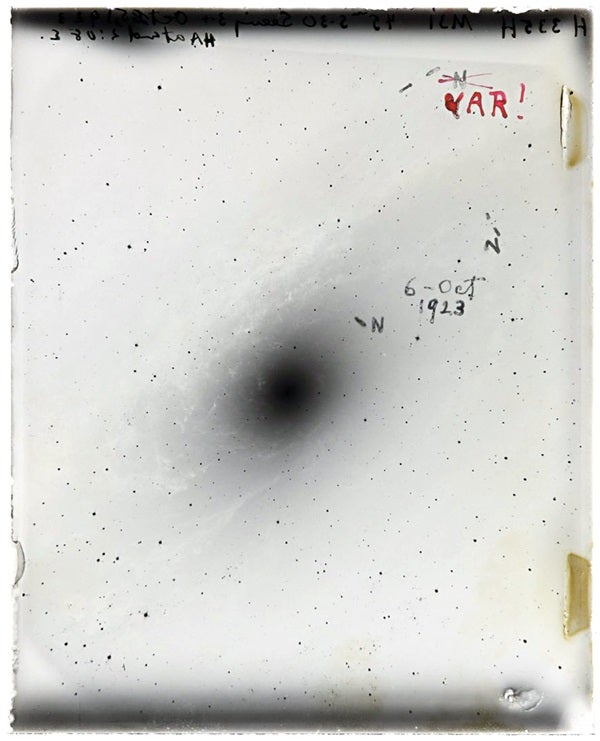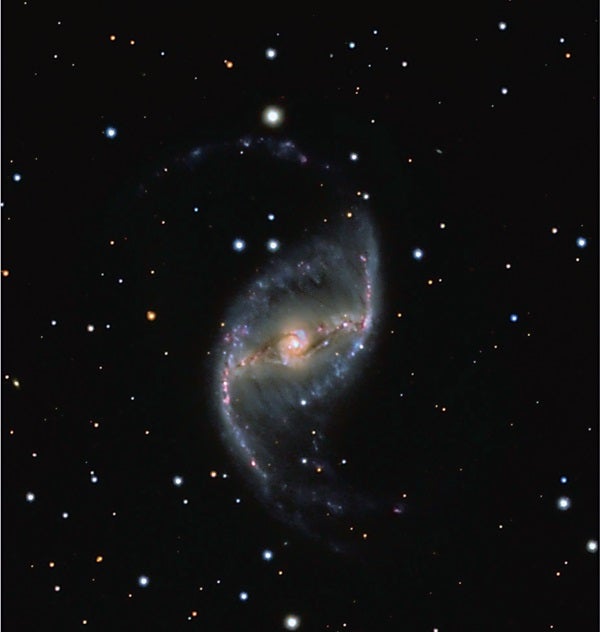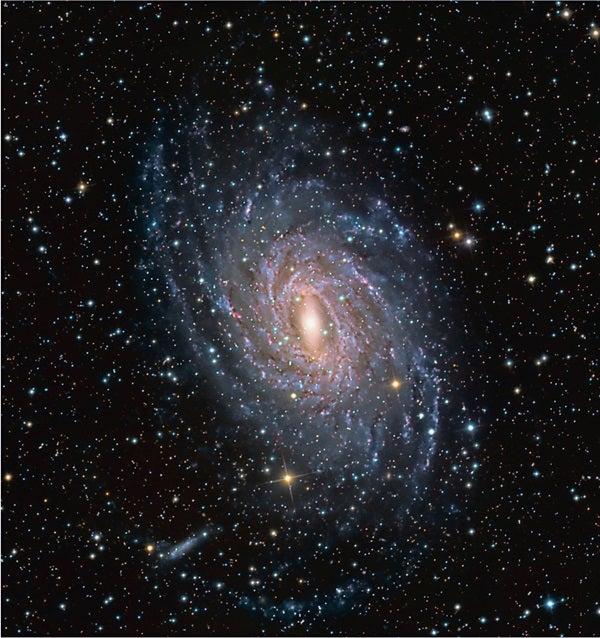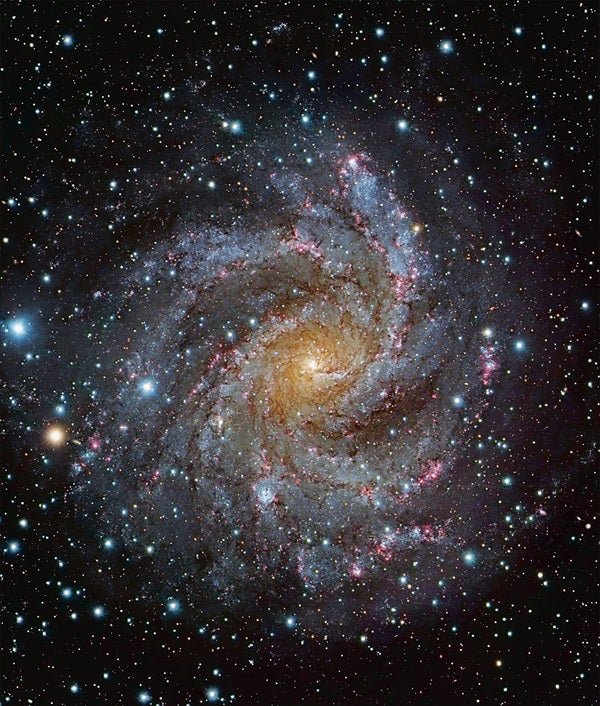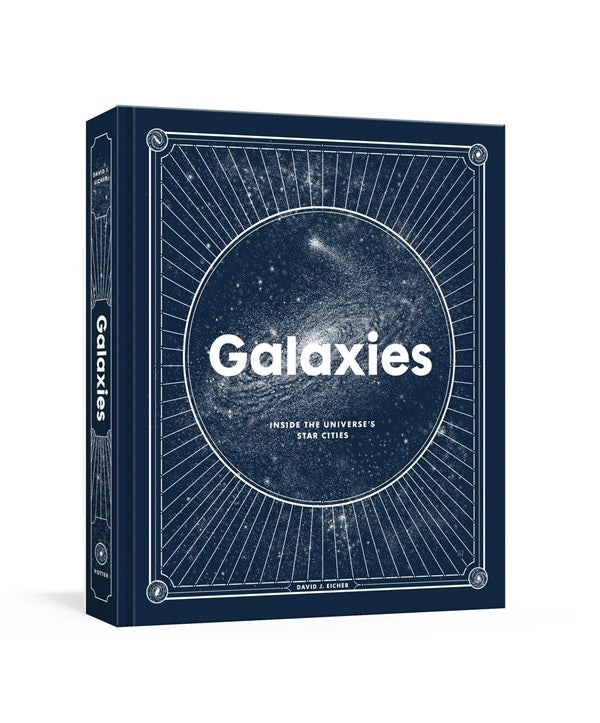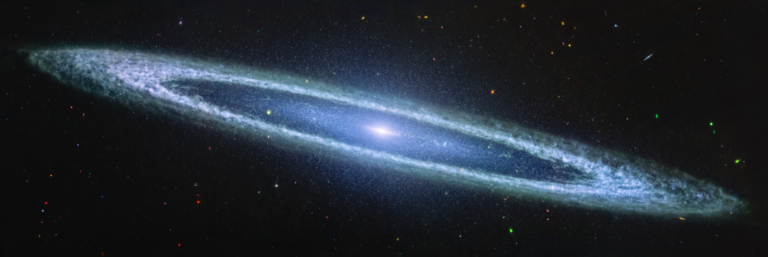Despite the area’s forward-looking involvement in science and technology, it was a primitive time. No one yet knew the size and scope of the universe. People had looked at the brightest galaxies in the sky — the fuzzy patches in Andromeda and the Magellanic Clouds in the Southern Hemisphere — but no one yet understood exactly what they were. One big question floated out there: How big is eternity? Is creation limitless? Soon, Los Angeles would play a pivotal role in defining the distance scale of the universe.
The 100-inch telescope
On October 4, 1923, in the midst of this peculiar Western paradise, a brash young astronomer left his Pasadena house and trekked up to the Mount Wilson Observatory, not far from Los Angeles, to the 100-inch Hooker Telescope — at the time the largest telescope in the world. Originally from Missouri, Edwin Powell Hubble had moved to Illinois, graduated from the University of Chicago, and then earned a master’s degree as a Rhodes Scholar at the University of Oxford. He had embarked on a career in astronomy only after returning to school at the age of 25 to pursue a Ph.D. Hubble was now in his fourth year as a staff astronomer at Mount Wilson. He relished using the 100-inch Hooker Telescope to study his favorite subject, the fuzzy nebulae — mysterious, glowing gas clouds that appeared scattered across the sky.
No one fully understood these nebulae, although they were suspected to be the birthplaces of stars. Using his mammoth telescope in rural Ireland in the mid-19th century, the adventurous amateur astronomer William Parsons, Third Earl of Rosse, had first sketched nebulae with spiral structures that looked like faintly glowing whirlpool patterns. But nearly a century later, little more was known about them. Hubble was interested in cracking the code of nebulae, particularly spiral nebulae. His Ph.D. work had centered on the topic. These nebulae’s spiral shapes suggested that they were rotating, but they otherwise mystified Hubble and other astronomers.
On the night of October 4, 1923, Hubble used the Hooker Telescope to take a 40-minute exposure of one of his favorite nebulae: the Great Nebula in the Andromeda constellation. This spiral-shaped cloud was large, bright, and faintly visible to the naked eye as a fuzzy smear of light for those located away from the city lights of Los Angeles. The night had very poor “seeing” when he took the exposure, because Earth’s atmosphere was relatively turbulent, and so the star images were not perfectly small dots. Nevertheless, Hubble’s examination of the photographic plate he had made revealed a suspected nova: an exploding star. It was exciting to record such a relatively rare event inside one of the spiral nebulae.
Hubble photographed the Andromeda Nebula again the next night, hoping for a better-quality image of the suspected nova. The resulting photographic glass plate, exposed the night of October 5/6 and designated H335H, would become one of the most celebrated in all of scientific history. On it, Hubble successfully recorded the nova again. But before he could analyze it further, his periodic observing run on the 100-inch telescope ended and he had to leave to accommodate other observers.
At his office in Pasadena, away from the mountaintop observatory, he continued studying earlier images taken by others of the Andromeda Nebula region. And then he made an unusual discovery. A nova brightens dramatically and then fades into oblivion. But the star he recorded appeared on older plates, brightening and fading regularly over a period of 31 days. This star was not a nova, then. It had to be some other kind of star inside the Andromeda Nebula.
The photographic plate that defined galaxies
On October 5/6, 1923, astronomer Edwin Hubble made an exposure of the “Andromeda Nebula” with the 100-inch Hooker Telescope at Mount Wilson Observatory near Los Angeles. He was initially excited, believing after analyzing the plate that he had recorded a nova — an exploding star. He marked the star, which lies between two tick marks he drew on the glass plate, with an “N.” The famous plate, designated H335H, would help to unlock one of the universe’s biggest secrets.
A short time later, Hubble realized he had not seen a nova, but a variable star of a particular type called a Cepheid, with very well-known characteristics. He then wrote “VAR!” on the plate. Because Cepheids’ absolute magnitudes and light curves were well known, Hubble could use the variable he’d found to determine the distance to its home in Andromeda. Astonished, Hubble found that the Andromeda Nebula was actually a distant galaxy, perhaps a million light-years away — far larger than astronomers believed the entire universe was at the time. With this plate, he unlocked the nature of galaxies. (It turns out, we now know, that the true distance to the Andromeda Galaxy is 2.5 million light-years.)
The image on the left shows the entire plate; the image on the right zooms in on Hubble’s notes. The plate belongs to the collection of the Carnegie Observatories in Pasadena, California, and is one of the most famous and influential images in the history of science.
Hubble’s breakthrough
Suddenly, Hubble came upon the solution. He realized that he had made an image of a type of star similar to a well-known one in the constellation Cepheus. On his photographic plate H335H, he crossed out “N,” for nova, and wrote “VAR!” instead, denoting a variable star. Moreover, this star was a special type of variable that brightened and faded in a precise way. Astronomers had long studied this kind of star, which came to be known as a Cepheid variable (after the star in Cepheus), and they knew how intrinsically bright it was. By knowing how bright the star really was, and by measuring how bright it appeared to be in the sky, Hubble could use the star as a guidepost to gauge its distance.
This was a monumental realization. Hubble calculated that, owing to the star’s faint light, it must lie a million light-years away — and so must the entire nebula surrounding it. This meant that the universe stretches across a distance at least three times larger than most astronomers then believed. With his photographic plate, Hubble had single-handedly reset the size of the cosmos.
Discovering the galaxies
Hubble’s discovery set off a firestorm of activity among astronomers researching other spiral nebulae. Countless observations followed, and follow-up studies rolled on for many months as bickering and soul-searching lit up the world of professional astronomy. Adding fuel to the fire was a debate staged several years earlier, in 1920, between two prominent astronomers of the day: Harlow Shapley of Princeton University, and Heber Curtis of the Allegheny Observatory. Shapley believed that the Milky Way Galaxy constitutes the entire universe, while Curtis speculated that spiral nebulae are galaxies separate from the Milky Way — essentially “island universes.” Though not everyone would concede it yet, Hubble’s discovery seemed to prove that Curtis was right.
Hubble continued imaging Cepheid variables in other spiral nebulae, such as M33 in Triangulum, demonstrating that they, like Andromeda, are so far away that they must be distant galaxies. Hubble’s observations indicated that galaxies are the basic units of stars, gas, and dust in the universe, and that they exist on a fantastic scale. He had many doubters, chief among them Shapley, but pushed on. The findings of the confident 35-year-old were subsequently splashed on the front page of The New York Times by November 1924. Egged on by supporters, he sent a paper summarizing the results to be read at the winter meeting of the American Astronomical Society, the professional organization of astronomers, on New Year’s Day 1925. After the distinguished professor Henry Norris Russell of Princeton University read the paper aloud at the gathering, galaxies were on their way to becoming widely accepted.
A breakthrough with galaxy colors
Several more years led to another huge advancement. A galaxy’s spectrum is a picture of the collected light from all of its stars and gas. In 1929, Hubble and other astronomers recorded many spectra of galaxies and noticed that most appeared to be shifted toward the red end of the spectrum, increasing the wavelength and lowering the frequency of their light. This was an effect first noticed years earlier, in 1912, by Vesto M. Slipher, an astronomer at Lowell Observatory in Arizona.
You experience this effect, called a Doppler shift, with sound every time an ambulance with its loud siren passes you. As it approaches, the siren seems high-pitched (because it has a short wavelength and high frequency of sound), and when it passes and heads away from you, the pitch drops lower (increasing the wavelength and lowering the frequency of sound). The same thing happens with light. When objects are moving toward us, the frequency of their light shifts higher, toward the blue end of the spectrum. When they are moving away from us, their light shifts lower, toward the red end of the spectrum. Consequently, the “redshift” of the spectra of distant galaxies indicates that the galaxies are moving away from us. And this means that the universe is not only immensely bigger than previously thought, but also that it is expanding to become even bigger as time marches on.
Here comes the Big Bang
Hubble’s work, building on the earlier studies of Slipher and astronomer Milton Humason, showed that, generally speaking, all galaxies are moving away from each other over time. Hubble also found that redshifts can be used to calculate distances to galaxies.
This research led to a monumental realization. In 1929, Hubble, with a helpful assist from the Belgian astronomer Georges Lemaître, suggested that the new data he collected about galaxies supported the theory that, if traced backward in time, the paths of all the galaxies led to a small, dense point at which the whole universe began — a “Big Bang” billions of years ago. This Big Bang commenced the expansion that is causing all galaxies to move apart from one another more quickly in space. The whole universe seems to be flying apart.
Hubble analyzed 46 galaxies and proposed what came to be known as the Hubble constant: the rate of expansion of the cosmos. He fixed this number as 500 kilometers per second per megaparsec of space, a much higher value than what we know is correct today.
Hubble and the expanding universe
Hubble’s credibility skyrocketed following the determination of an expanding universe. This was big stuff: Hubble had piled on lots of supporting evidence for the ideas of the great physicist Albert Einstein, who had proposed that time and space are expanding and that the cosmos is almost unimaginably large.
By the late 1930s, following Hubble’s big discoveries, it was becoming clear just how significant galaxies are to the story of the cosmos. Astronomers knew that most of the immensely large universe is filled with darkness. Little matter exists outside the island galaxies, which contain all the bright stuff, the normal matter — stars, gas, dust, and planets. The universe is like a vast and stormy sea, with little ships — galaxies — floating on a virtually limitless ocean of utter darkness and with a foreboding void between them.
Classifying galaxies
By this time, Hubble understood the broad types of galaxies, which he classified in a “tuning fork” diagram. There are spiral galaxies, like Andromeda, and barred spirals — similar to spiral galaxies but containing a rectangular “bar” of material through their centers. There are ellipticals: spherical masses of stars, gas, and dust. There are lenticulars, which appear lens-shaped; and there are irregulars, relatively formless clouds of matter lacking organized structure. In the late 1930s, astronomers discovered examples of a new class, dwarf spheroidal galaxies, and later found so-called peculiar galaxies, which seem highly distorted. By the end of the 1950s, they had devised an improved way to classify galaxies, based on the research of the French astronomer Gérard de Vaucouleurs of the University of Texas.
Examples of all these types of galaxies can be viewed with a telescope from a dark-sky site. They include:
Spiral galaxies: The Sunflower Galaxy (M63), IC 342, and NGC 1232
Barred spiral galaxies: NGC 1300, NGC 1512, NGC 1530, NGC 4921, and NGC 5701
Elliptical galaxies: M49, M87, and NGC 1052
Lenticular galaxies: M84, NGC 2787, and NGC 4111
Irregular galaxies: NGC 1569, NGC 3239, and NGC 4214
Peculiar galaxies: Arp 81, Arp 220, Centaurus A, Fornax A, M82, and Perseus A
De Vaucouleurs’ classification scheme was more complex, forming a 3D “cosmic lemon” that accounted for more properties of the basic types of galaxies. For spiral galaxies, this included further details on bars, whether a galaxy showed rings of encircling material, and how tightly or loosely wound the arms appeared to be. De Vaucouleurs also cataloged details about irregular galaxies and described peculiar galaxies, which had experienced galactic train wrecks — interactions with nearby galaxies that warped their shapes.
The incredible scope of the cosmos
For years, astronomers have quoted the results of deep galaxy surveys that suggest something like 100 billion galaxies exist in the universe. A 2016 study suggests that the total number of galaxies could be 2 trillion. But that study looks back into the early universe, and many galaxies have merged over time, creating a smaller “current” number like 100 billion. We are hanging out in just one of them, the Milky Way. These basic structures of the cosmos, like ships floating on an ocean of vast darkness, give us a glimpse beyond our world to understand the meaning of why we’re here.
In our spaceship, let’s set out from the Milky Way Galaxy, our home. The closest galaxy we can encounter is the Sagittarius Dwarf Spheroidal Galaxy, a tiny galaxy that orbits ours. If we move at the speed of light, it would take us 70,000 years to reach this galaxy. Another way of thinking about these enormous distances is to understand how long the light that we now see from other galaxies has been traveling through space to reach us. The light from the Sagittarius Dwarf Spheroidal Galaxy has traveled since humans made their earliest bits of art inside caves in South Africa. If we traveled for 163,000 years in our spaceship, we could arrive at the Large Magellanic Cloud, our galaxy’s largest satellite. Traveling for 200,000 years would carry us to the Small Magellanic Cloud, another satellite of our Milky Way. The light you see from this galaxy tonight has traveled through space since our earliest human ancestors closely linked to our species walked the African plains.
But those are dwarf galaxies that are very close to us. The largest nearby galaxy is the Andromeda Galaxy, which would take us 2.5 million years to reach in our spaceship. The light you see from this galaxy tonight has traveled through space since some of our earliest human ancestors were here on Earth.
And these are just some of the galaxies closest to us. Traveling outward, you would find countless examples of strange and beautiful galaxies at all manner of distances. These would include spirals like IC 239, M100, M106, NGC 210, NGC 2683, NGC 2841, NGC 3310, NGC 3338, NGC 4565, and NGC 6946. You would encounter fields of multiple galaxies like those in the Leo Trio (M65, M66, and NGC 3628), M81 and M82, and the galaxy group Hickson 31. Some galaxies that seem to be connected, like NGC 3314, would grow away from each other as you approached and their visual alignment disappeared. You would encounter numerous weird, distorted galaxies — the result of interactions or disruptions by black holes — like Arp 188, ESO 243-49, NGC 474, NGC 660, NGC 2685, NGC 4622, NGC 5291, NGC 7714, and UGC 697.
You can see how enormous the cosmos is and understand that, fundamentally, it is filled with galaxies. The Virgo Cluster galaxies would take 50 million years to reach in our light-speed spaceship. More distant galaxies are arranged in clusters and superclusters that we can see from Earth, and some lie hundreds of millions or billions of light-years away. Reaching the most distant galaxies that we can see would take us more than 13 billion years, traveling at the speed of light.
Living our lives on this third planet from the Sun in our solar system, it’s easy to ignore how unbelievably immense the universe is. But moving farther and farther out into the universe to explore galaxies allows us to understand how the universe came to be, and where it’s going.
Explore galaxies from home
Galaxies: Inside the Universe’s Star Cities by David J. Eicher (Clarkson Potter, 2020) presents the amazing story of our knowledge of the great star systems populating the cosmos. Inspired by Tim Ferris’ 1980 book Galaxies, the new work updates the story of what we know about the fundamental systems of stars, gas, and dust into the 21st century.
Galaxies: Inside the Universe‘s Star Cities contains 200 color photographs and diagrams showing and explaining the many types of galaxies and how astronomers have come to understand key questions about them over just the last generation. Cutting-edge imagery from the Hubble Space Telescope and many ground-based observatories helps to tell the tale of our understanding of galaxy formation and evolution via mergers, combining small blobs into the larger, organized structures like our Milky Way we see today. The greatest recent images by amateur astronomers show the many spectacular forms and colors of spirals, barred spirals, ellipticals, and others.
The book explores the subject of galaxies traveling into the deep cosmos, from seeing the band of light of our Milky Way overhead in your backyard to understanding the barred spiral structure of our own galaxy, a relatively recent discovery. We explore the Local Group of galaxies, the Virgo Cluster, the Local Supercluster, and the largest structures in the universe — walls, sheets, and filaments spanning billions of light-years.
The extensive text describes all of the most amazing and recently discovered aspects of galaxies, from supermassive black holes to dark matter to the fate of our galaxy and of the universe itself.

